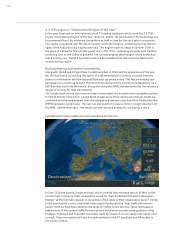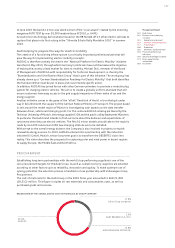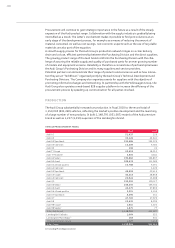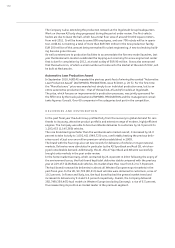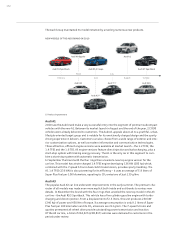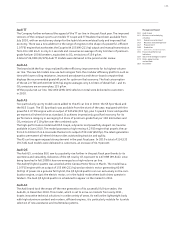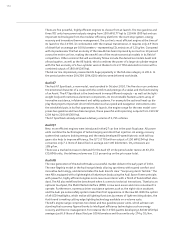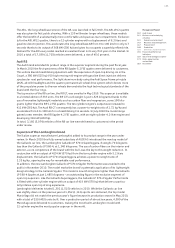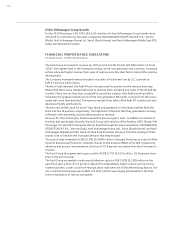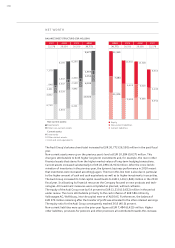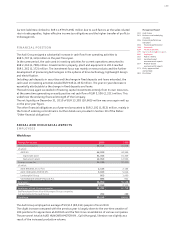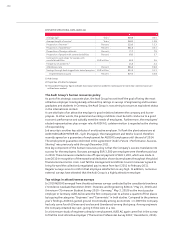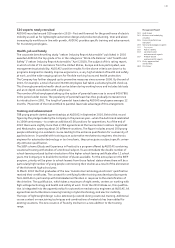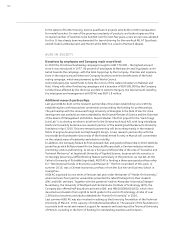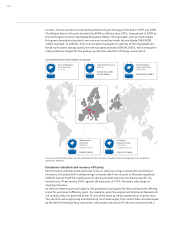Audi 2010 Annual Report Download - page 156
Download and view the complete annual report
Please find page 156 of the 2010 Audi annual report below. You can navigate through the pages in the report by either clicking on the pages listed below, or by using the keyword search tool below to find specific information within the annual report.
154
There are five powerful, highly efficient engines to choose from at launch. The two gasoline and
three TDI units have power outputs ranging from 130 kW (177 hp) to 220 kW (300 hp) and use
important technologies from the modular efficiency platform: the start-stop system, energy
recovery and innovative thermo-management. The car line’s most efficient engine at the time of
its launch is the 2.0 TDI. In combination with the manual transmission, it requires only 4.9 liters
of diesel fuel on average per 100 kilometers – representing CO₂ emissions of 129 g/km. Compared
with its predecessor the fuel economy of the new A6 has been improved by as much as 19 percent
across the entire car line, making the new A6 one of the most economical models in its field of
competitors. Other versions that will eventually follow include the derivative models Avant and
allroad quattro, as well as the A6 hybrid, which combines the power of a large six-cylinder engine
with the fuel economy of a four-cylinder version thanks to its 2.0 TFSI and electric motor with a
combined output of 180 kW (245 hp).
The A6 car line impressively reasserted its huge popularity in the full-size category in 2010. In
the period under review 204,309 (194,620) vehicles were delivered worldwide.
Audi A7
The Audi A7 Sportback, a new model, was launched in October 2010. The five-door car combines
the emotional character of a coupe with the comfort and prestige of a sedan and the functionality
of an Avant. The A7 Sportback is the benchmark in many different respects – as well as the light-
weight body with numerous aluminum components, its most notable features are its array of
innovative assistance, infotainment and safety systems. For example the optional head-up dis-
play that projects important driver information such as speed and navigation instructions onto
the windshield puts in its first appearance. At launch, the engine range for the new model com-
prises two gasoline and two diesel engines, these powerful units spanning outputs from 150 kW
(204 hp) to 220 kW (300 hp).
The A7 Sportback already achieved a delivery volume of 3,795 vehicles.
Audi Q7
New, more efficient engines were introduced in the Q7 car line in the past fiscal year. All power
units combine the technologies of turbocharging and direct fuel injection. An energy recovery
system that captures braking energy and the newly developed 8-speed tiptronic with tall top
gears also help to improve efficiency. The Q7 3.0 TDI with an output of 150 kW (204 hp) thus
consumes only 7.2 liters of diesel fuel on average over 100 kilometers. CO₂ emissions are
189 g/km.
There was a marked increase in demand for the Audi Q7 in the period under review. At 43,251
(35,606) units, the delivery volume was 21.5 percent up on the prior-year total.
Audi A8
The new generation of the Audi A8 made a successful market debut in the early part of 2010.
The new flagship model in the Audi range blends alluring sportiness with superb comfort and
innovative technology, and demonstrates the Audi brand’s clear “Vorsprung durch Technik.” The
new A8 is equipped with a lightweight all-aluminum body using the Audi Space Frame principle,
with powerful, highly efficient engines and a luxurious interior with a finish of handcrafted stan-
dard. The A8 also redefines the benchmark when it comes to technical innovations. Thanks to an
optional touchpad, the Multi Media Interface (MMI) is now even easier and more convenient to
operate. Furthermore, numerous driver assistance systems such as the night vision assistant
and the Audi pre sense safety system make their first appearance in the new A8. With the option
of all-LED headlights, which realize all lighting functions by means of light-emitting diodes, the
Audi brand is making cutting-edge lighting technology available on a volume scale.
The A8’s engine range comprises two diesel and two gasoline power units, which achieve out-
standing fuel economy figures thanks to intelligent efficiency technologies such as energy
recovery and thermo-management. For instance the 3.0 TDI quattro developing 184 kW (250 hp)
averages just 6.6 liters of diesel fuel per 100 kilometers and thus emits only 174 g CO₂/km.


